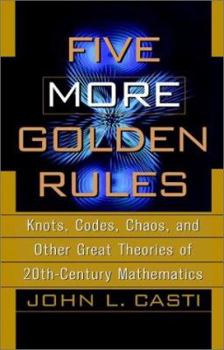Five More Golden Rules: Knots, Codes, Chaos, and Other Great Theories of 20th-Century Mathematics
Select Format
Select Condition 
Book Overview
Casti is one of the great science writers. -San Francisco Examiner Casti's gift is to be able to let the nonmathematical reader share in his understanding of the beauty of a good theory. This description may be from another edition of this product.
Format:Paperback
Language:English
ISBN:0471395285
ISBN13:9780471395287
Release Date:February 2001
Publisher:John Wiley & Sons
Length:268 Pages
Weight:0.85 lbs.
Dimensions:0.8" x 6.1" x 9.2"
Customer Reviews
3 ratings
nice sequel to Five golden rules but heavy on the mathematics
Published by Thriftbooks.com User , 16 years ago
In Five Golden Rules John Casti wrote a wonderful book about important theorems in mathematics that were discovered in the 20th Century. The style and description was such that a layperson could understand, enjoy and appreciate the results. All the theorems were discovered before 1950 and they all dealt with topics in applied mathematics and particularly game theory and operations research. Perhaps he found the list of five golden rules too restrictive and thus comes the sequel "Five More Golden Rules". Again, it would be hard to argue the choices. Casti goes into the details of the theorems and the theory related to them much like he did in the first book. However, in this book, he has chosen topics from very abstract areas of mathematics. I have a masters degree in mathematics and a Ph.D. in statistics and yet I had no familiarity with knot theory. So I learned a lot from chapter 1 but found it to be difficult reading, more like a mathematics textbook than a popular book for the scientist and layman. This feeling continued as I read the other four chapters even though I was treading on territory that was very familiar to me (e.g. the Kalman filter of control theory). It was reassuring to me to see that this impression was also shared by the three customers that had already written reviews on the book. I recommend this book wholeheartedly for mathematicians and other with strong math training. The Hahn-Banach theorem was the most important theorem that I learned about when I took my functional analysis course at the University of Maryland some 26 years ago. But I have not had much use for it since and I completely forgot what it said. Casti provides me with a nice reminder and shows how this result is a generalization of very practical results that relate to quantum mechanics and other results in physics. The latter part of the 20th Century saw a great deal of activity in nonlinear dynamics. This is connected by Casti to the Hopf Bifurcation theorem. That chapter deals with many topics that grasped the attention of applied mathematicians, including chaos and catastrophy theory, strange attractors and the beautiful geometry of fractals. This material is not for a layperson. On the other hand, the introduction to the chapter, covering what a dynamical system is, provides a wonderful analogy to a treasure hunt in Central Park that can be appreciated by everyone. The Kalman filter provides an example of how linearization of real dynamic systems allows one to write a prediction equation for the state at the next time point recursively as a function of the current state and the new measurements. This recursive formulation leads to the same solution that Wiener had found much earlier, but because of the recursion, it is much more suitable for real time computer applications. This was essential to controlling space vehicles and is the important result that made the trip to the moon possible. Casti covers the theory of Kalman filtering very well but
MEANT for non-mathematicians???
Published by Thriftbooks.com User , 22 years ago
I'm math and computer science student. I have studied linear algebra and know lots about linear spaces, n-dimensional vectors, matrices and other stuff. Still I sometimes found it hard to get out proof or just idea of those formulas. Why do you need formula, if you can't understant its essence. Then there are lots of calculus expressions. I DON'T think it's for everyone!BUT, I found the book SPLENDID just because of those subjects covered - and covered quite generally without too deep details (although sometimes I wanted more).I certainly don't agree with those folks who say that there is no explanation on subject's importance. There is ENOUGH! Then I ask you: "Why did you buy that book? Just randomly?" If you have little gray cells in your box then you'll understand why something is or isn't important. I DON'T have need for lengthy texts of explanations why this and not other subject. That is boring!
Not bad--very scientific, not for the lay person
Published by Thriftbooks.com User , 24 years ago
This book was a good look at some of the newer, yet important laws that govern physisc, and science altogether. I found it well-written, fascinating and a fun book to read. I would not recommend it to a person without a strong scientific background, as the author makes many assumptions about the readers knowledge.






